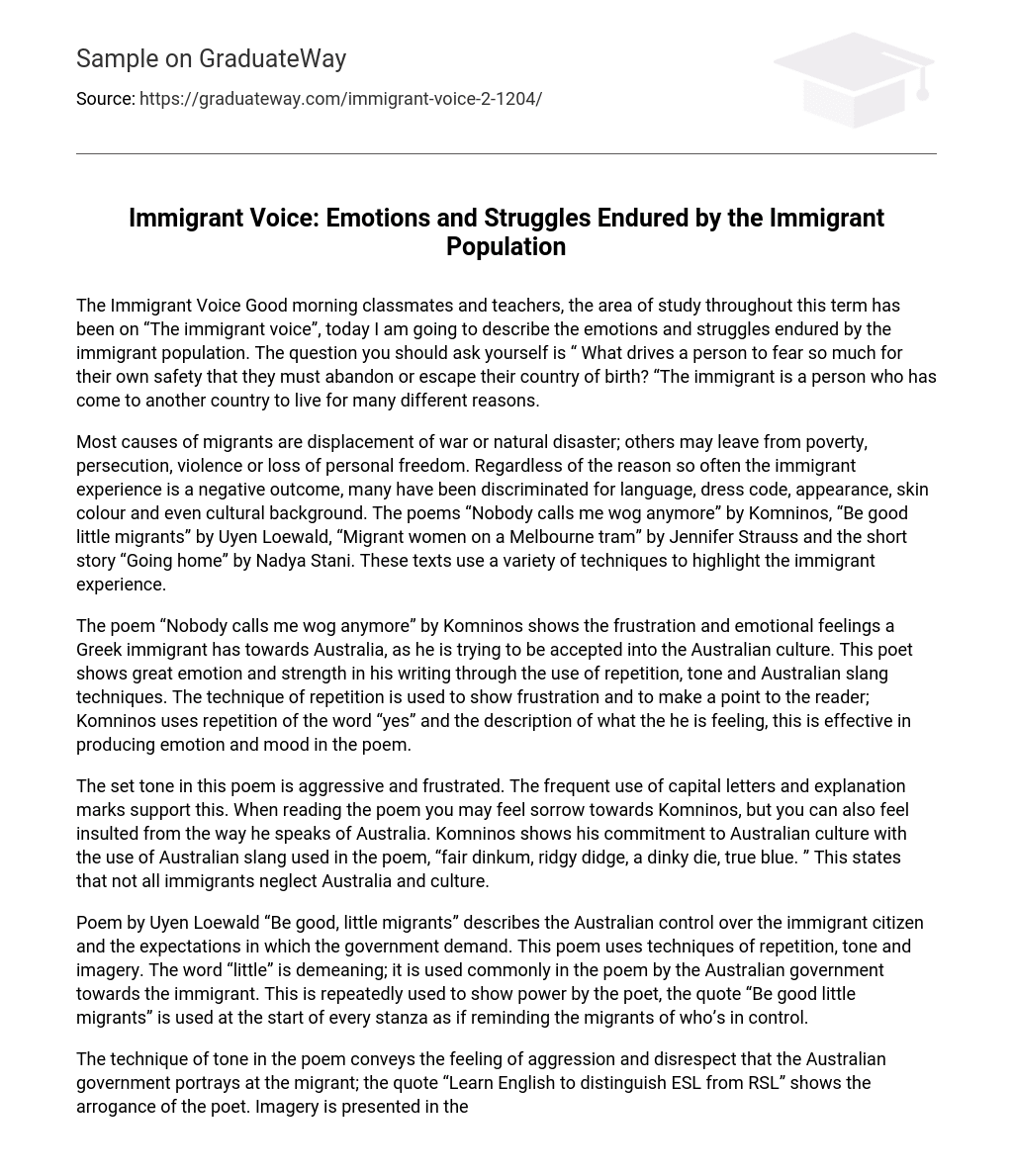The Immigrant Voice Good morning classmates and teachers, the area of study throughout this term has been on “The immigrant voice”, today I am going to describe the emotions and struggles endured by the immigrant population. The question you should ask yourself is “ What drives a person to fear so much for their own safety that they must abandon or escape their country of birth? “The immigrant is a person who has come to another country to live for many different reasons.
Most causes of migrants are displacement of war or natural disaster; others may leave from poverty, persecution, violence or loss of personal freedom. Regardless of the reason so often the immigrant experience is a negative outcome, many have been discriminated for language, dress code, appearance, skin colour and even cultural background. The poems “Nobody calls me wog anymore” by Komninos, “Be good little migrants” by Uyen Loewald, “Migrant women on a Melbourne tram” by Jennifer Strauss and the short story “Going home” by Nadya Stani. These texts use a variety of techniques to highlight the immigrant experience.
The poem “Nobody calls me wog anymore” by Komninos shows the frustration and emotional feelings a Greek immigrant has towards Australia, as he is trying to be accepted into the Australian culture. This poet shows great emotion and strength in his writing through the use of repetition, tone and Australian slang techniques. The technique of repetition is used to show frustration and to make a point to the reader; Komninos uses repetition of the word “yes” and the description of what the he is feeling, this is effective in producing emotion and mood in the poem.
The set tone in this poem is aggressive and frustrated. The frequent use of capital letters and explanation marks support this. When reading the poem you may feel sorrow towards Komninos, but you can also feel insulted from the way he speaks of Australia. Komninos shows his commitment to Australian culture with the use of Australian slang used in the poem, “fair dinkum, ridgy didge, a dinky die, true blue. ” This states that not all immigrants neglect Australia and culture.
Poem by Uyen Loewald “Be good, little migrants” describes the Australian control over the immigrant citizen and the expectations in which the government demand. This poem uses techniques of repetition, tone and imagery. The word “little” is demeaning; it is used commonly in the poem by the Australian government towards the immigrant. This is repeatedly used to show power by the poet, the quote “Be good little migrants” is used at the start of every stanza as if reminding the migrants of who’s in control.
The technique of tone in the poem conveys the feeling of aggression and disrespect that the Australian government portrays at the migrant; the quote “Learn English to distinguish ESL from RSL” shows the arrogance of the poet. Imagery is presented in the poem giving the reader the impression that migrants are worthless and third rate citizens. The Australian government is almost blackmailing the migrants in saying we saved you from your country now you must abide by our rules and do the jobs that no one else will do.
Jennifer Strauss’s poem “Migrant women on a Melbourne tram” is a great example of the feeling of lost of culture and country of a migrant in a foreign country. Many techniques have been demonstrated in this poem. The three I believe show the emotions of the migrant experience are emotive language, metaphor and imagery. Emotive language allows the reader to better understand and a chance to imagine the experience of the immigrant, “she is forlorn in foreign words and voices” describes the feeling of isolation, nervous and being lost.
The metaphor in this poem is about symbolising death from poverty, “Where poverty is white as bone” telling the reader of the importance of wealth in certain cultures, no money means no life. Imagery in this poem is the poet trying to identify the English words on street signs, showing the frustration and confusion of the foreign women. “Going Home” by Nadya Stani is my chosen relative text. This text is hostile and uncaring towards Australia, it has been written in the eyes of an immigrant and shows anger and aggression.
Techniques used in the texts are metaphor, tone and emotive/ racial language. The tone in this text is aggressive, hostile and confrontational. The poet is discriminative to Australia and its loyal soldiers and ANZAC’s, when you read this text as an Australian, you feel anger and hatred, thinking what gives this person the right to speak this way about our country! The Metaphor “The Hell that was migration… ” has been used to exaggerate the experience of migration, the struggles faced and the discrimination against them.
The quote “I think about going to the land of milk and honey” is almost a biblical reference to the bible and Moses, taking his people to a safe place. The emotive and racial language in this text is towards Australian people neglecting immigrants “dirty Arabs”, “dumb wog” these are the poet’s thoughts of Australia’s attitudes to migrants. To me these 4 texts represent the different feelings, emotions and challenges experienced by migrants. Expressing both the migrants and Australian citizens thoughts towards each other, and the tension between them. Thank you for your time.





